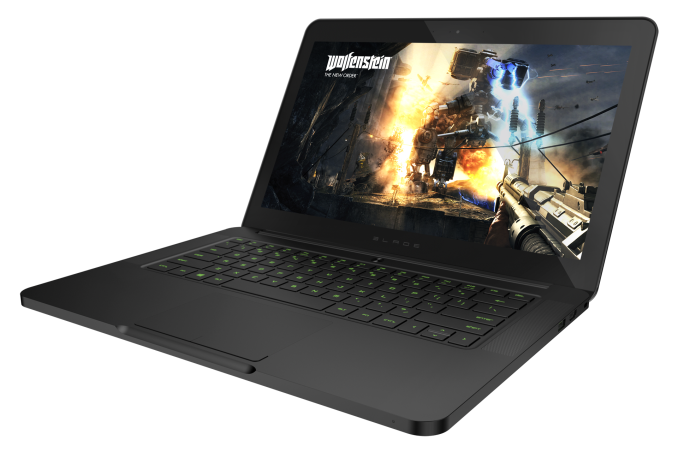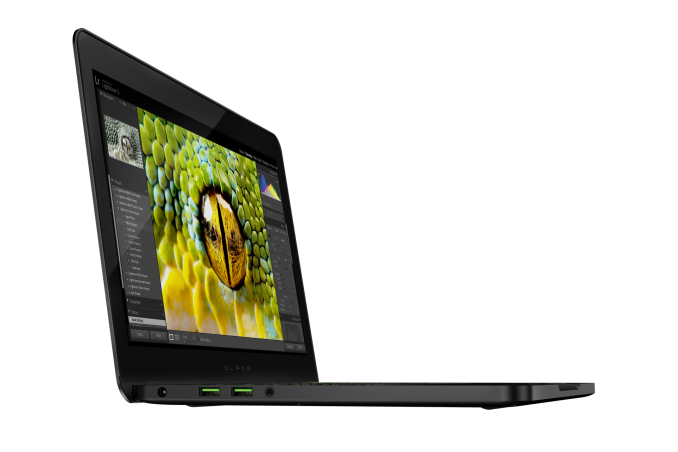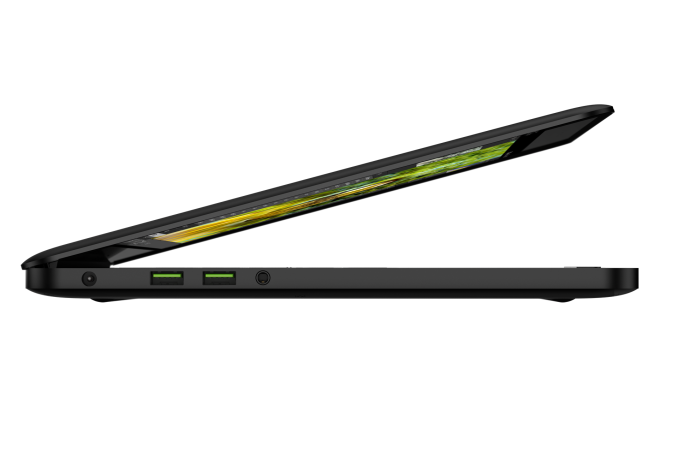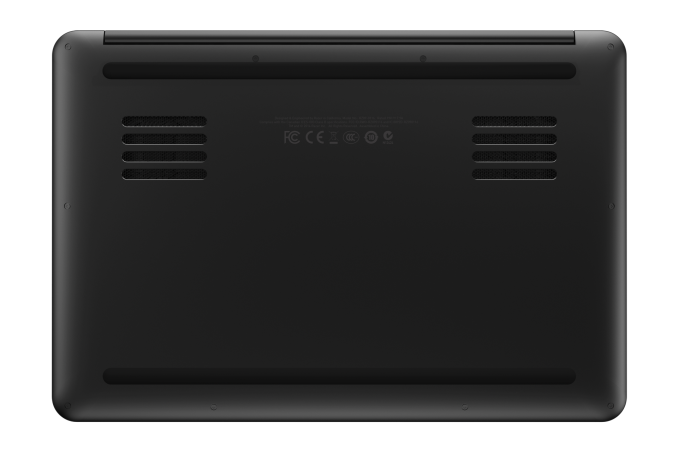Razer Announces the New Razer Blade: 14” QHD+ with GTX 870M
by Ian Cutress on March 12, 2014 2:54 PM EST
Gaming based laptops have boomed in recent months and quarters. There are plenty of companies getting their feet wet and some are trying to push the limits. QHD+ is starting to look like a new standard in the higher end laptops, as seen in the 13.3” Lenovo Yoga 2 Pro and the 15” Dell XPS 15 (read Jarred’s review of the XPS 15 here), and Razer are deciding to go with something similar for the 2014 Razer Blade refresh.
Aside from the touchscreen 14” QHD+ panel, which is an IGZO panel rather than the pentile screen seen on the Lenovo, the New Razer Blade 2014 edition is equipped with an Intel Core i7-4702HQ quad core processor, 8GB of DDR3L-1600 and the recently announced NVIDIA GTX 870M. That sounds like a beefy machine to begin with, and beats out the old Razer Blade that only had a 1600x900 panel and a GTX 765M.
This new device measures 345x235x17.9mm, which Razer likes to point out is smaller than a dime. The machine isn’t the lightest, weighing in at 4.47 lbs (2.03 kg), but we do get an Intel 7260 2x2 802.11ac WiFi module in there as well as a choice of SATA M.2 drives. Razer is accepting preorders based solely on the size of the M.2 drive: $2200 for a 128GB, $2400 for 256GB and $2700 for 512GB.
The keyboard is fully backlit in green, and the laptop uses a 70Wh battery with a 150W power adapter. This makes sense, given the CPU is a 37W part and the GPU is set to be rated around 100W. This would reinforce the image on Razer’s website of dual fans in the chassis. Connectivity comes via three USB 3.0 ports, a HDMI 1.4a port and headphone/microphone jacks.
| Razer Blade 14-Inch Specifications | |||||
|
2013 (Current) |
2014 (New) |
||||
| Processor |
Intel Core i7-4702HQ (4x2.2GHz + HTT, Turbo to 3.2GHz, 22nm, 6MB L3, 37W) |
Intel Core i7-4702HQ (4x2.2GHz + HTT, Turbo to 3.2GHz, 22nm, 6MB L3, 37W) |
|||
| Chipset | Intel HM87 | Intel HM87 | |||
| Memory | 8GB DDR3L-1600 | 8GB DDR3L-1600 | |||
| Graphics |
NVIDIA GeForce GTX 765M 2GB GDDR5 768 CUDA cores, 797MHz/863MHz core 4GHz memory 128-bit memory bus Intel HD 4600 Graphics (20 EUs, up to 1.15GHz) |
NVIDIA GeForce GTX 870M 3GB GDDR5 1344 CUDA cores, 941 MHz core 5 GHz memory clocks 192-bit memory bus Intel HD 4600 Graphics (20 EUs, up to 1.15GHz) |
|||
| Display |
14" LED Matte 16:9 900p AU Optronics AUO103E |
14" IGZO 16:9 3200x1800 Multitouch with LED Backlight |
|||
| Hard Drive(s) |
Samsung PM841 256GB mSATA 6Gbps SSD |
128GB / 256GB / 512 GB SATA M.2 |
|||
| Optical Drive | - | - | |||
| Networking |
Killer Wireless-N 1202 Dual Band 2x2 802.11a/b/g/n Bluetooth 4.0 |
Intel Wireless-AC 7260HMW Dual Band 2x2 802.11a/b/g/n/ac Bluetooth 4.0 |
|||
| Audio |
Realtek ALC269 HD audio Stereo speakers Combination mic/headphone jack |
? | |||
| Battery | 70Wh | 70Wh | |||
| Front Side | - | - | |||
| Right Side |
USB 3.0 HDMI 1.4a Kensington lock |
USB 3.0 HDMI 1.4a Kensington Lock |
|||
| Left Side |
AC adapter 2x USB 3.0 Combination mic/headphone jack |
AC adapter 2x USB 3.0 Combination mic/headphone jack |
|||
| Back Side | - | - | |||
| Operating System | Windows 8 64-bit | Windows 8.1 64-bit | |||
| Dimensions |
13.6" x 9.3" x 0.66" 345mm x 235mm x 16.8mm |
13.6" x 9.3 " x 0.70" 345mm x 235mm x 17.9mm |
|||
| Weight |
4.1 lbs 1.88 kg |
4.47 lbs 2.03 kg |
|||
| Extras |
Webcam USB 3.0 Killer Networks wireless networking Backlit anti-ghosting keyboard |
2.0 MP Webcam USB 3.0 Intel 2x2 802.11ac Backlit anti-ghosting keyboard |
|||
| Warranty | 1-year limited | ? | |||
| Pricing | $1,799 | Starting at $2200 for 128GB | |||
Powering 5.76 million pixels in QHD+ rather than 2.07 million of 1080p means an almost three-fold increase, and 4x over the older Razer Blade at 900p. That begs the question as to what frame rates we might see at 3200x1800 in this new device. I doubt that BF4 will be running at some high quality settings at 3200x1800, but I like the fact that the industry is headed to higher density panels in a smaller chassis.
Because I have been lax at being a proper gamer these past few years, my eyes would really open to a version of this without the discrete GPU – give me a high density, top quality panel with a lot of battery life and my usual OS, and all is good. However for running around to a LAN, it would either be an SFF machine or something like this that would fit right in.
Razer is taking pre-orders for shipping next month. In an interview with TechCrunch, Razer CEO Min-Liang Tan explained how the company has listened to their customers, and aim to help alleviate the previous issues regarding keeping up with demand. Markets like Russia and Taiwan will follow after North America.




















56 Comments
View All Comments
madmilk - Thursday, March 13, 2014 - link
Not everyone will buy this for gaming. There's definitely demand for a powerful quad cire ultrabook. Look at the 15" rMBP: the $2600 model has 16GB of memory by default, and the new Blade is basically a Windows version of that with a much more powerful graphics card.Penti - Wednesday, March 12, 2014 - link
So they aim at 1600x900 gaming? Guess that's what you get when you just do off the self builds. No DisplayPort? That's a big mistake, most use external monitors and want to use these as desktop replacements.dragonsqrrl - Wednesday, March 12, 2014 - link
That's what I assumed initially, but then I saw that they put an 860M in their 17" model with a 1080p display. The way they designed the two laptops seems to be under the assumption that you're going to be gaming at the native resolutions, which in the case of the 14" Blade seems absolutely absurd.To me it would've made a lot more sense to put an 860M in the 14" and 870M in the 17". I think the benefits of Maxwell in the smaller lower TDP form factor would far outweigh the performance disadvantages compared to an 870M. It would still be perfectly capable of gaming at 900p, neither would be capable of gaming at 1800p. For newer titles some big sacrifices would have to be made, either frame rate or quality settings, neither of which sounds like a compelling experience... to me at least.
Penti - Wednesday, March 12, 2014 - link
Nvidia drivers/gpu do scaling just fine, so it's obviously not meant to run at native res. GPU might be fine for 1080 gaming, 4x scaling is probably what people will use though. Switching the gpus around from the 17 to the 14 would have made a lot more sense.dragonsqrrl - Wednesday, March 12, 2014 - link
... I'm not sure you really got what I was talking about.The reason it seems like Razor is implying that the user should be gaming at the native res of the displays, and if not the native res then at least a higher res on the 14" model than the 17", is because of the GPU SKUs they included in each laptop relative to their native resolutions. 1080p is paired with 860M, 1800p paired with 870M. It has nothing to do with Nvidia driver scaling (whatever it is you meant by that, I have no idea). If they intended users to game at 900p, like both you and I have suggested (and which makes a whole lot more sense to me), why would they put the more powerful GPU in the 14" model?
"GPU might be fine for 1080 gaming, 4x scaling is probably what people will use though."
I'm assuming you're referring to the 870M? ...actually I don't know, but I'll just role with that. The reason I suggested 900p was because it's a clean quarter resolution of 1800p, not because the 870M wouldn't be able to run games at higher resolutions. I'm sure it probably could run a lot of games just fine at 1080p, but that would lead to artifacting as a result of the displays native resolution. I guess some people don't mind this, but I do, and I'd imagine a lot of people who would be in the market for a more elegant solution like a Razer Blade would probably mind too.
Egg - Thursday, March 13, 2014 - link
I agree that the GPUs should probably be switched, as you said.I don't think that any of this implies running at native resolution, though. QHD isn't feasible.
Penti - Thursday, March 13, 2014 - link
4x scaling means 1600x900. As I implied at the top of this thread. In effect they are not urging or encouraging users to drive a higher res then the old Blade has. Gaming at that seems to be the only reasonable decision users can do on the Blade 14. They hardly imply native res. 870M would probably do 1080 gaming on the 17-inch Blade Pro just fine. 860M is weaker. So it would be better of doing 1600x900 outputted to 3200x1800 by the driver. That was only brought up to point out that they probably should switch. To match respective model better than today.The design choices doesn't seem to have been made at the same time when regarding these two models. But I don't know if the 860M is the Kepler or Maxwell part for that matter. I didn't register that they actually had a model with the 860M part before the dragon squirrel wrote though.
lmcd - Sunday, May 4, 2014 - link
Honestly, I'd prefer the 760m Maxwell in the 14-inch Razer Blade even at the same price. It could've been thinner with less focus on the heat characteristics and maybe even broken into the upper 3 lb range.Kevin G - Thursday, March 13, 2014 - link
I'll second the need for DisplayPort. It is great when paired with an MST hub to drive multiple monitors when you have them.Penti - Thursday, March 13, 2014 - link
Or just a monitor at above 1920x1200.